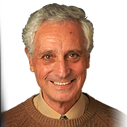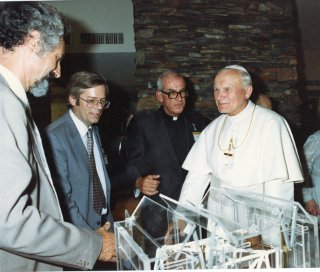It was during our discussions on how to make mirrors for big telescopes that the National Observatory was working on ways of building a National New Technology Telescope. They wanted it to be a very large telescope. We had an optics meeting at Kitt Peak headquarters to discuss the development, and Roger and I put together a paper for this. Roger was very busy observing quasars at the time, and I said, “Look, Roger, this is a paper for the next development on from the MMT. I’m prepared to do the work and write the paper, but I need you to talk things through with me.” He said “okay”, so I began work on a telescope concept and kept taking it back to him. In the end he had been converted from quasar observations into wanting to make huge telescope mirrors!
With Pope John Paul II: Nick Woolf with Roger Angel and Fr. George Coyne showing a model of the Large Binocular Telescope to the Pope.
Credit: Image courtesy of Nick Woolf
Once we started thinking about such a telescope, there were two tasks that needed addressing. The first was to make larger mirrors, and the second was to work out how to make mirrors that could adapt to changing air temperature and produce sharper images. At the time, it had been believed that images of 1-2 seconds of arc in diameter were produced by the atmosphere and that the image quality was limited by the atmosphere. But, based on our MMT experience, we said, “Absolutely not. What we think of as degraded image quality because of the atmosphere is partly due to the telescopes themselves, and we can do far better.”
And indeed, that proved to be the case. There have been a couple of ways of making mirrors that adapted to atmospheric temperature change: one of them has been to use the honeycomb cast mirrors that Roger has now built for many telescopes. Another has been to make the mirror from a solid glass slab, as thin as one can support well, by the old conventional technique and then flowing a very uniform sheet of air temperature across its surface at night. That can also work fairly well, although my impression is that it is not quite as good as actually having a telescope mirror at the right temperature. There is a third technique of making a tiled mirror, but it is not clear that the thermal problems of such a mirror can be well solved.
So Roger started experimenting with making a new kind of mirror. After he’d gone to the point of making one six foot in diameter with a focal ratio of f/1.0, which was extraordinary for any telescope, I spoke to George Coyne at the Vatican Observatory and I said, “George, you need a telescope at an ideal site and I know where to get a mirror for it.” That was how the Vatican Observatory telescope came into being and I was part of the design team for that.


